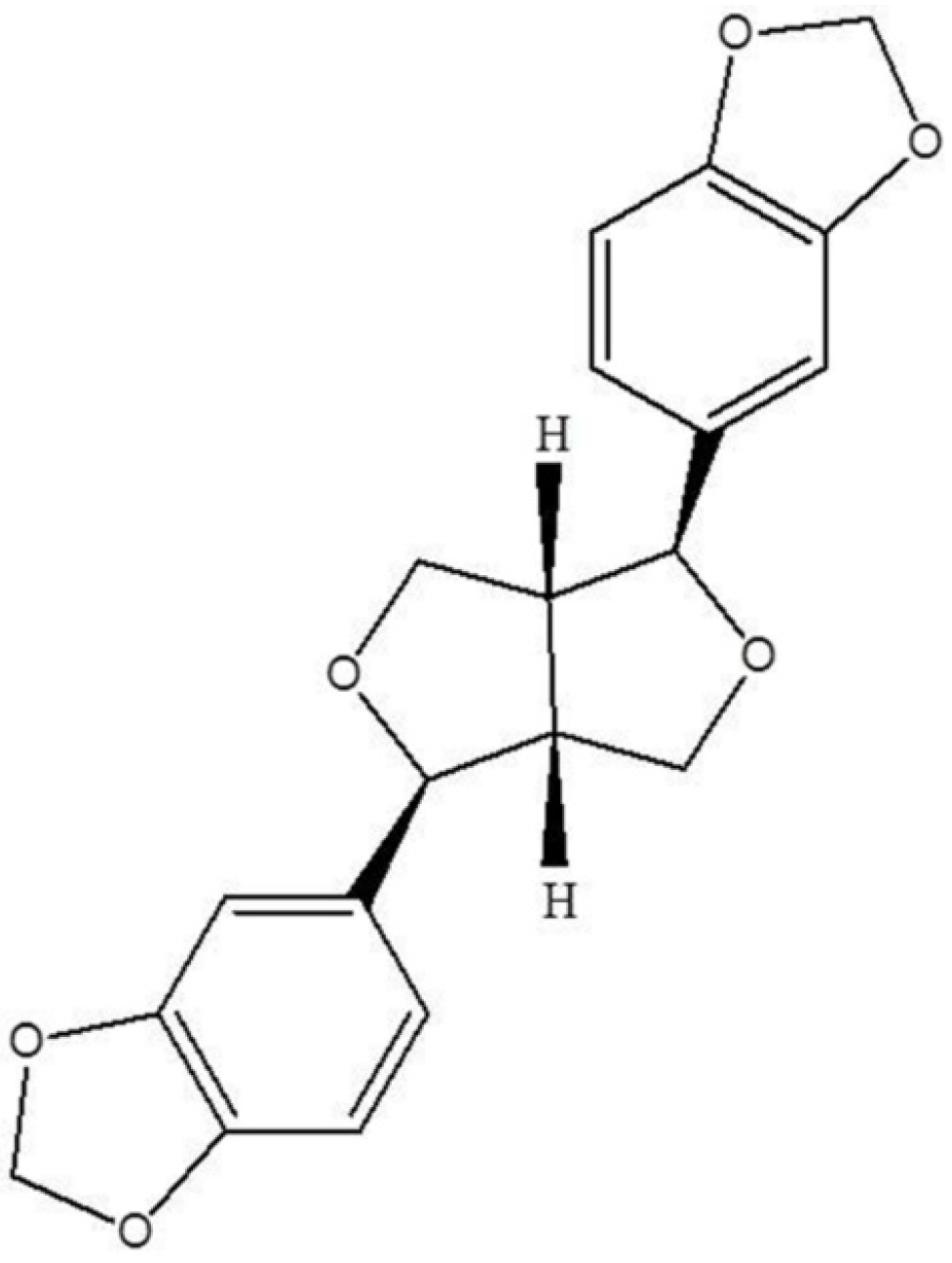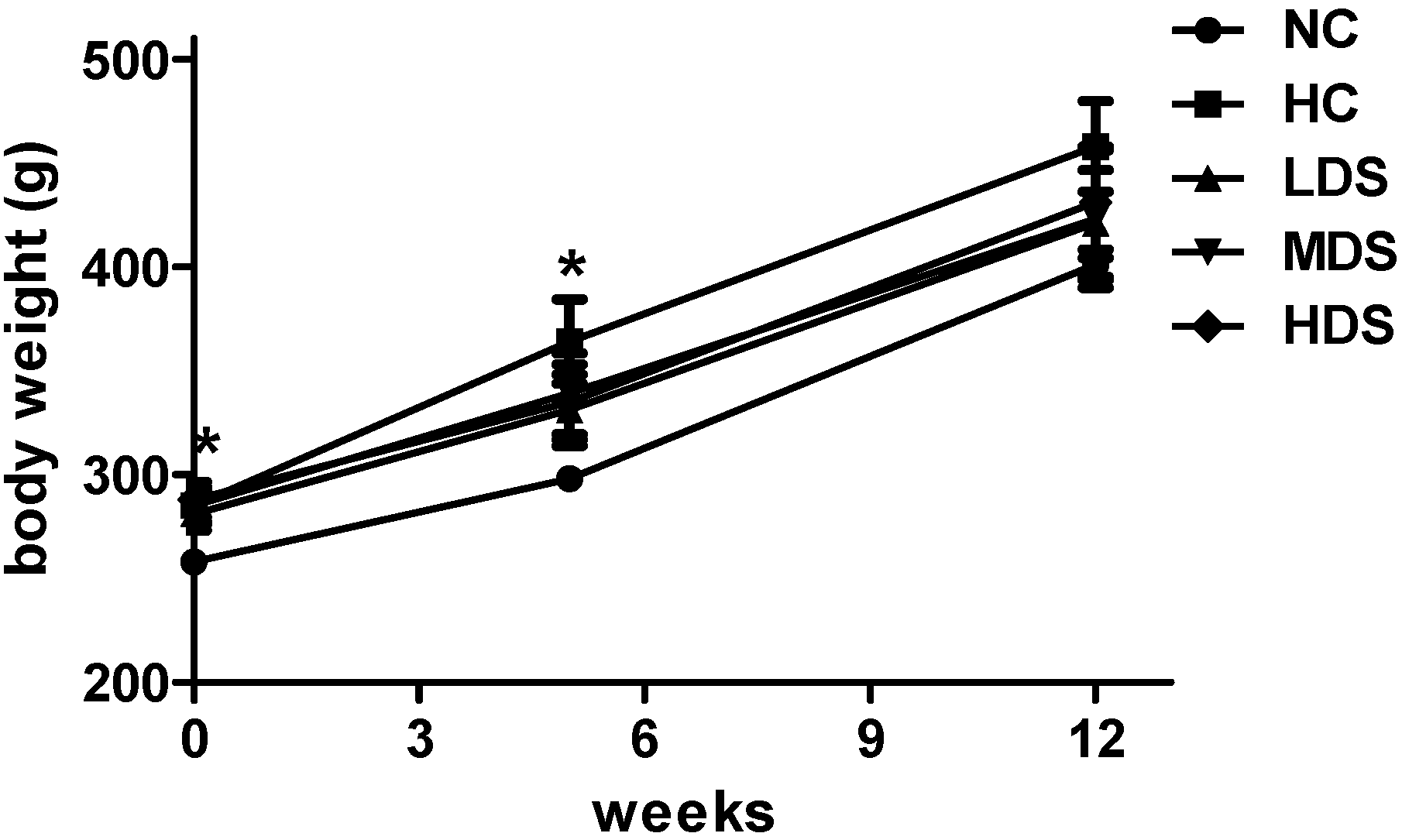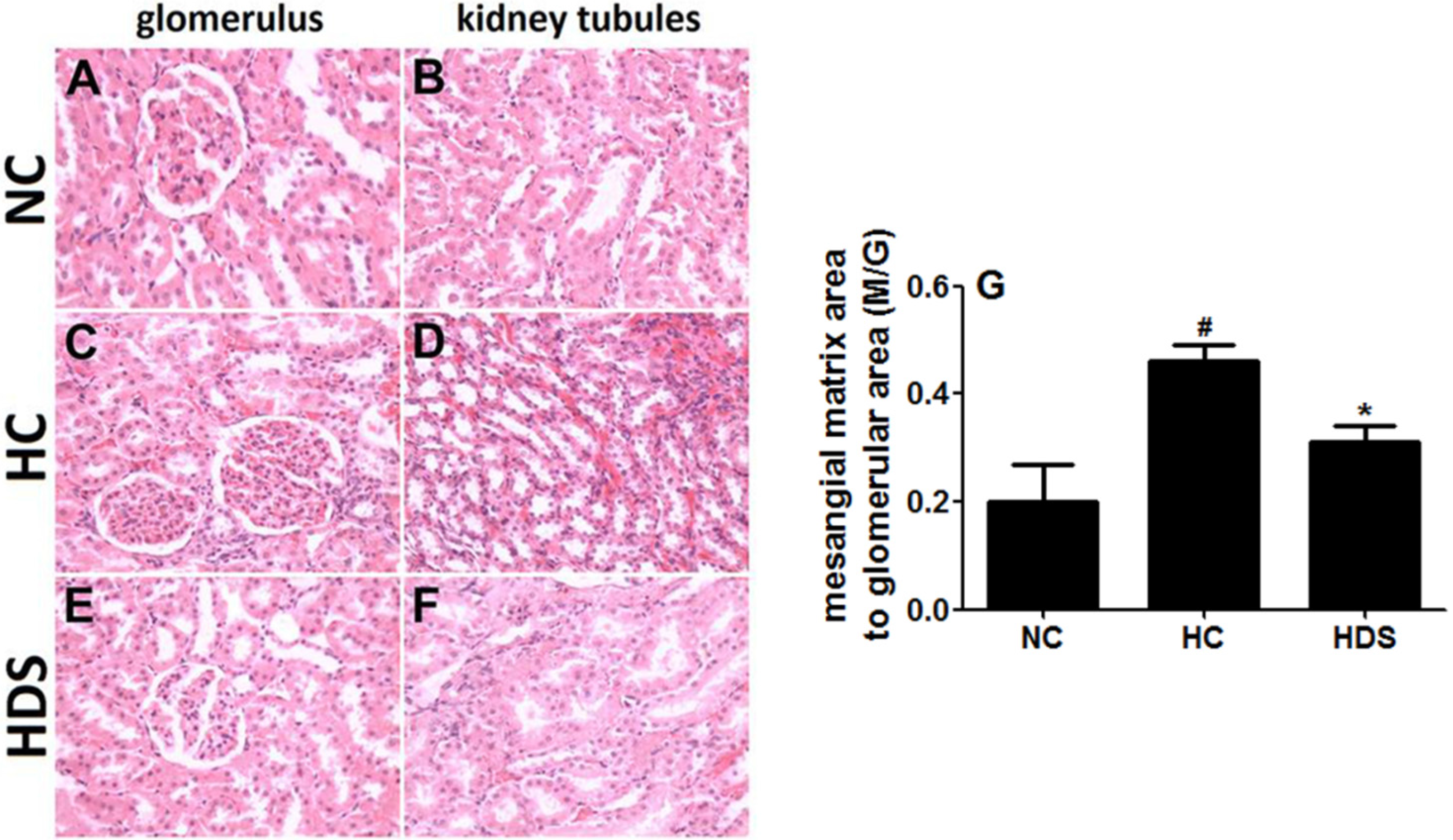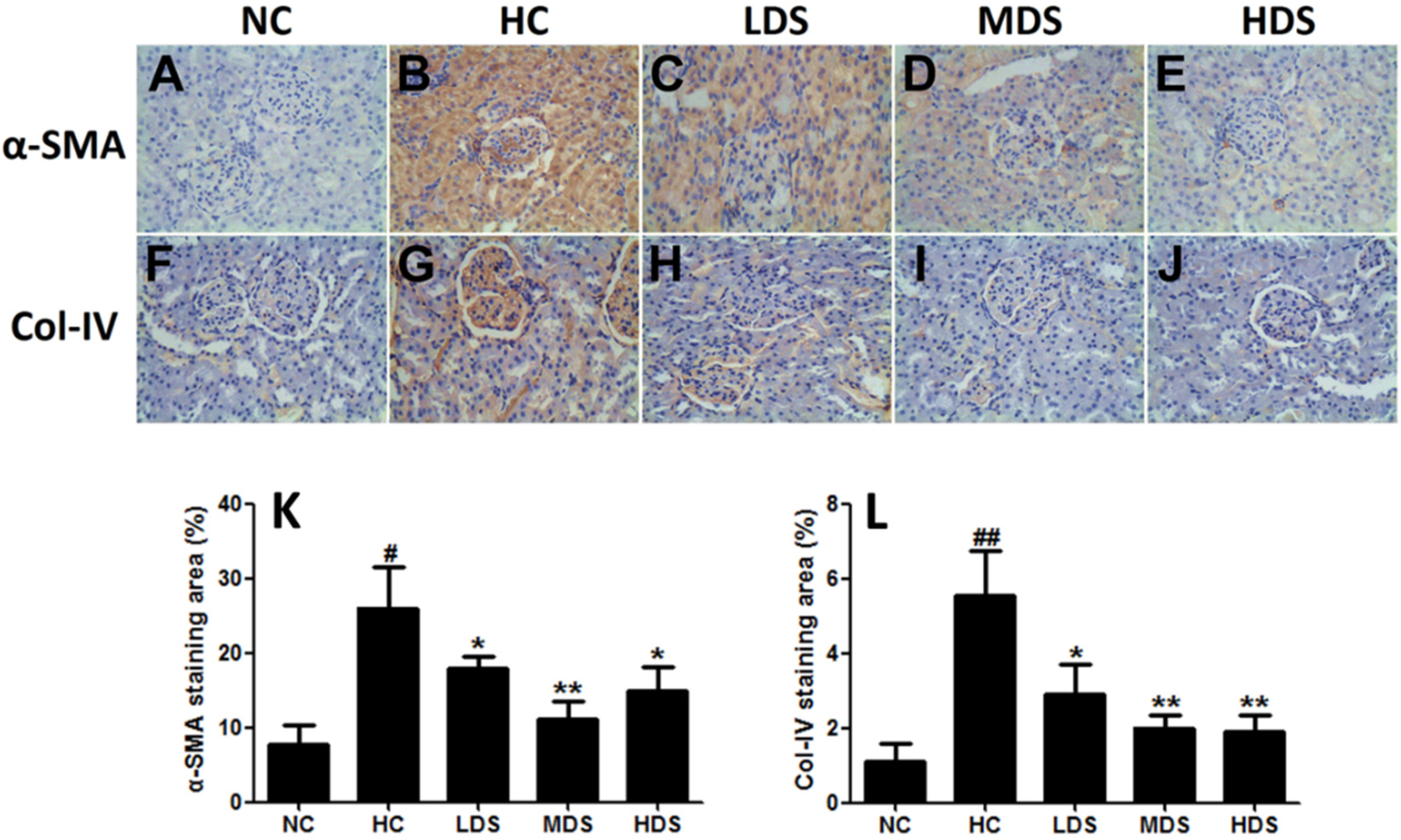Sesamin Ameliorates High-Fat Diet–Induced Dyslipidemia and Kidney Injury by Reducing Oxidative Stress
Abstract
:1. Introduction
2. Materials and Methods
2.1. Materials
2.2. Animals
2.3. Induction of Hyperlipidemia in the Rat Model
2.4. Sample Collection
2.5. Immunohistochemical Analysis of α-SMA and Col-IV Protein Expressions
2.6. Histopathological Examination
2.7. Statistical Analysis
3. Results
3.1. Body Weight, Blood Lipids and Apolipoprotein Changes
3.2. Renal and Liver Function Indicator Changes
3.3. Renal Histological Changes
3.4. α-SMA and Col-IV Expression in Renal Tissues
4. Discussion
5. Conclusions
Acknowledgments
Author Contributions
Conflicts of Interest
Abbreviations
| TC: | Total cholesterol |
| TG: | triglyceride |
| LDL-C: | low density lipoprotein cholesterol |
| apo-B: | apolipoprotein B |
| SCr: | serum creatinine |
| CKDs: | Chronic Kidney Diseases |
| ROS: | Reactive Oxygen Species |
| Col-IV: | rabbit anti-collagen-IV |
| HC: | hyperlipidemic group |
| 24 h-UTP: | 24 h urinary protein |
| Ualb: | urinary albumin |
| HDL-C: | high-density lipoprotein cholesterol |
| apo-A: | apolipoprotein A |
| BUN: | blood urea nitrogen |
| HE: | Hematoxylin and Eosin |
| PAS: | Periodic Acid-Schiff reaction |
| SOD: | Superoxide Dismutase |
| MDA: | Malondialdehyde |
| ANOVA: | analysis of variance |
| ALT: | alanine aminotransferase activity |
References
- Mathieu, P.; Lemieux, I.; Despres, J.P. Obesity, inflammation, and cardiovascular risk. Clin. Pharmacol. Ther. 2010, 87, 407–416. [Google Scholar] [CrossRef] [PubMed]
- Declèves, A.E.; Mathew, A.V.; Cunard, R.; Sharma, K. AMPK mediates the initiation of kidney disease induced by a high-fat diet. J. Am. Soc. Nephrol. 2011, 22, 1846–1855. [Google Scholar] [CrossRef] [PubMed]
- Moorhead, J.F.; Chan, M.K.; El-Nahas, M.; Varghese, Z. Lipid nephrotoxicity in chronic progressive glomerular and tubulo-interstitial disease. Lancet 1982, 2, 1309–1311. [Google Scholar] [CrossRef]
- Chen, J.; Muntner, P.; Hamm, L.L.; Jones, D.W.; Batuman, V.; Fonseca, V.; Whelton, P.K.; He, J. The metabolic syndrome and chronic kidney disease in U.S. adults. Ann. Intern. Med. 2004, 140, 167–174. [Google Scholar] [CrossRef] [PubMed]
- Go, A.S.; Chertow, G.M.; Fan, D.; McCulloch, C.E.; Hsu, C.Y. Chronic kidney disease and the risks of death, cardiovascular events, and hospitalization. N. Engl. J. Med. 2004, 351, 1296–1305. [Google Scholar] [CrossRef] [PubMed]
- Deji, N.; Kume, S.; Araki, S.; Soumura, M.; Sugimoto, T.; Isshiki, K.; Chin-Kanasaki, M.; Sakaguchi, M.; Koya, D.; Haneda, M.; et al. Structural and functional changes in the kidneys of high-fat diet-induced obese mice. Am. J. Physiol. Ren. Physiol. 2008, 296, F118–F126. [Google Scholar] [CrossRef] [PubMed]
- Nelson, R.G.; Bennett, P.H.; Beck, G.J.; Tan, M.; Knowler, W.C.; Mitch, W.E.; Hirschman, G.H.; Myers, B.D. Development and progression of renal disease in Pima Indians with non-insulin-dependent diabetes mellitus. Diabetic Renal Disease Study Group. N. Engl. J. Med. 1996, 335, 1636–1642. [Google Scholar] [CrossRef] [PubMed]
- Dominguez, J.H.; Tang, N.; Xu, W.; Evan, A.P.; Siakotos, A.N.; Agarwal, R.; Walsh, J.; Deeg, M.; Pratt, J.H.; March, K.L.; et al. Studies of renal injury III: Lipid-induced nephropathy in type II diabetes. Kidney Int. 2000, 57, 92–104. [Google Scholar] [CrossRef] [PubMed]
- Keane, W.F. The role of lipids in renal disease: Future challenges. Kidney Int. 2000, 57, S27–S31. [Google Scholar] [CrossRef]
- Trevisan, R.; Dodesini, A.R.; Lepore, G. Lipids and renal disease. J. Am. Soc. Nephol. 2006, 17, S145–S147. [Google Scholar] [CrossRef] [PubMed]
- Martinez-Garcia, C.; Izquierdo, A.; Velagapudi, V.; Vivas, Y.; Velasco, I.; Campbell, M.; Burling, K.; Cava, F.; Ros, M.; Oresic, M.; et al. Accelerated renal disease is associated with the development of metabolic syndrome in a glucolipotoxic mouse model. Dis. Model. Mech. 2012, 5, 636–648. [Google Scholar] [CrossRef] [PubMed]
- Munoz-Garcia, B.; Moreno, J.A.; Lopez-Franco, O.; Sanz, A.B.; Martin-Ventura, J.L.; Blanco, J.; Jakubowski, A.; Burkly, L.C.; Ortiz, A.; Egido, J.; et al. Tumor necrosis factor-like weak inducer of apoptosis (tweak) enhances vascular and renal damage induced by hyperlipidemic diet in apoe-knockout mice. Arterioscler. Thromb. Vasc. Biol. 2009, 29, 2061–2068. [Google Scholar] [CrossRef] [PubMed]
- Ruan, X.Z.; Varghese, Z.; Moorhead, J.F. An update on the lipid nephrotoxicity hypothesis. Nat. Rev. Nephrol. 2009, 5, 713–721. [Google Scholar] [CrossRef] [PubMed]
- Li, Q.; Jiang, Y.; Jiang, S.; Li, Y.; Jiang, L.; Wang, J. Sesamin attenuates lipopolysaccharide-induced acute lung injury by inhibition of tlr4 signaling pathways. Inflammation 2016, 39, 467–472. [Google Scholar]
- Cao, J.; Chen, J.; Xie, L.; Wang, J.; Feng, C.; Song, J. Protective properties of sesamin against fluoride-induced oxidative stress and apoptosis in kidney of carp (cyprinus carpio) via jnk signaling pathway. Aquat. Toxicol. 2015, 167, 180–190. [Google Scholar] [CrossRef] [PubMed]
- Tada, M.; Ono, Y.; Nakai, M.; Harada, M.; Shibata, H.; Kiso, Y.; Ogata, T. Evaluation of antioxidative effects of sesamin on the in vivo hepatic reducing abilities by a radiofrequency esr method. Anal. Sci. 2013, 29, 89–94. [Google Scholar] [CrossRef] [PubMed]
- Hsieh, P.F.; Hou, C.W.; Yao, P.W.; Wu, S.P.; Peng, Y.F.; Shen, M.L.; Lin, C.H.; Chao, Y.Y.; Chang, M.H.; Jeng, K.C. Sesamin ameliorates oxidative stress and mortality in kainic acid-induced status epilepticus by inhibition of mapk and cox-2 activation. J. Neuroinflamm. 2011, 8, 57. [Google Scholar] [CrossRef] [PubMed]
- Song, J.L.; Choi, J.H.; Seo, J.H.; Kil, J.H.; Park, K.Y. Antioxidative effects of fermented sesame sauce against hydrogen peroxide-induced oxidative damage in llc-pk1 porcine renal tubule cells. Nutr. Res. Pract. 2014, 8, 138–145. [Google Scholar] [CrossRef] [PubMed]
- Periasamy, S.; Yang, S.S.; Chen, S.Y.; Chang, C.C.; Liu, M.Y. Prophylactic sesame oil attenuates sinusoidal obstruction syndrome by inhibiting matrix metalloproteinase-9 and oxidative stress. J. Parenter. Enter. Nutr. 2013, 37, 529–537. [Google Scholar] [CrossRef] [PubMed]
- Ide, T.; Ashakumary, L.; Takahashi, Y.; Kushiro, M.; Fukuda, N.; Sugano, M. Sesamin, a sesame lignan, decreases fatty acid synthesis in rat liver accompanying the down-regulation of sterol regulatory element binding protein-1. Biochim. Biophys. Acta 2001, 1534, 1–13. [Google Scholar] [CrossRef]
- Lim, J.S.; Adachi, Y.; Takahashi, Y.; Ide, T. Comparative analysis of sesame lignans (sesamin and sesamolin) in affecting hepatic fatty acid metabolism in rats. Br. J. Nutr. 2007, 97, 85–95. [Google Scholar] [CrossRef] [PubMed]
- Chiang, H.M.; Chang, H.; Yao, P.W.; Chen, Y.S.; Jeng, K.C.; Wang, J.S.; Hou, C.W. Sesamin reduces acute hepatic injury induced by lead coupled with lipopolysaccharide. J. Chin. Med. Assoc. 2014, 77, 227–233. [Google Scholar] [CrossRef] [PubMed]
- Zhang, J.X.; Yang, J.R.; Chen, G.X.; Tang, L.J.; Li, W.X.; Yang, H.; Kong, X. Sesamin ameliorates arterial dysfunction in spontaneously hypertensive rats via downregulation of nadph oxidase subunits and upregulation of enos expression. Acta Pharmacol. Sin. 2013, 34, 912–920. [Google Scholar] [CrossRef] [PubMed]
- Noeman, S.A.; Hamooda, H.E.; Baalash, A.A. Biochemical study of oxidative stress markers in the liver, kidney and heart of high fat diet induced obesity in rats. Diabetol. Metab. Syndr. 2011, 3, 17. [Google Scholar] [CrossRef] [PubMed]
- Henegar, J.R.; Bigler, S.A.; Henegar, L.K.; Tyagi, S.C.; Hall, J.E. Functional and structural changes in the kidney in the early stages of obesity. J. Am. Soc. Nephrol. 2001, 12, 1211–1217. [Google Scholar] [PubMed]
- Periasamy, S.; Hsu, D.Z.; Chang, P.C.; Liu, M.Y. Sesame oil attenuates nutritional fibrosing steatohepatitis by modulating matrix metalloproteinases-2, 9 and ppar-gamma. J. Nutr. Biochem. 2014, 25, 337–344. [Google Scholar] [CrossRef] [PubMed]
- Schaffer, J.E. Lipotoxicity: When tissues overeat. Curr. Opin. Lipidol. 2003, 14, 281–287. [Google Scholar] [CrossRef] [PubMed]
- Ji, J.; Zhang, C.; Luo, X.; Wang, L.; Zhang, R.; Wang, Z.; Fan, D.; Yang, H.; Deng, J. Effect of stay-green wheat, a novel variety of wheat in China, on glucose and lipid metabolism in high-fat diet induced Type 2 diabetic rats. Nutrients 2015, 7, 5143–5155. [Google Scholar] [CrossRef] [PubMed]
- Hirose, N.; Inoue, T.; Nishihara, K.; Sugano, M.; Akimoto, K.; Shimizu, S.; Yamada, H. Inhibition of cholesterol absorption and synthesis in rats by sesamin. J. Lipid Res. 1991, 32, 629–638. [Google Scholar] [PubMed]
- Monteiro, E.M.; Chibli, L.A.; Yamamoto, C.H.; Pereira, M.C.; Vilela, F.M.; Rodarte, M.P.; Pinto, M.A.; do Amaral, M.P.; Silvério, M.; Araújo, A.L.; et al. Antinociceptive and anti-inflammatory activities of the sesame oil and sesamin. Nutrients 2014, 6, 1931–1944. [Google Scholar] [CrossRef] [PubMed]
- Kong, X.; Wang, G.D.; Ma, M.Z.; Deng, R.Y.; Guo, L.Q.; Zhang, J.X.; Yang, J.R.; Su, Q. Sesamin ameliorates advanced glycation end products-induced pancreatic β-cell dysfunction and apoptosis. Nutrients 2015, 7, 4689–4704. [Google Scholar] [CrossRef] [PubMed]
- Reagan-Shaw, S.; Nihal, M.; Ahmad, N. Dose translation from animal to human studies revisited. FASEB J. 2008, 22, 659–661. [Google Scholar] [CrossRef] [PubMed]
- Wu, W.H.; Kang, Y.P.; Wang, N.H.; Jou, H.J.; Wang, T.A. Sesame ingestion affects sex hormones, antioxidant status, and blood lipids in postmenopausal women. J. Nutr. 2006, 136, 1270–1275. [Google Scholar] [PubMed]
- Scheuer, H.; Gwinner, W.; Hohbach, J.; Grone, E.F.; Brandes, R.P.; Malle, E.; Olbricht, C.J.; Walli, A.K.; Grone, H.J. Oxidant stress in hyperlipidemia-induced renal damage. Am. J. Physiol. Ren. Physiol. 2000, 278, F63–F74. [Google Scholar]
- Boyle, S.C.; Liu, Z.; Kopan, R. Notch signaling is required for the formation of mesangial cells from a stromal mesenchyme precursor during kidney development. Development 2014, 141, 346–354. [Google Scholar] [CrossRef] [PubMed]
- Grabias, B.M.; Konstantopoulos, K. Epithelial-mesenchymal transition and fibrosis are mutually exclusive reponses in shear-activated proximal tubular epithelial cells. FASEB J. 2012, 26, 4131–4141. [Google Scholar] [CrossRef] [PubMed]
- Sung, W.J.; Kim, K.H.; Kim, Y.J.; Chang, Y.C.; Lee, I.H.; Park, K.K. Antifibrotic effect of synthetic smad/sp1 chimeric decoy oligodeoxynucleotide through the regulation of epithelial mesenchymal transition in unilateral ureteral obstruction model of mice. Exp. Mol. Pathol. 2013, 95, 136–143. [Google Scholar] [CrossRef] [PubMed]
- Liu, M.; Liu, Y.Z.; Feng, Y.; Xu, Y.F.; Che, J.P.; Wang, G.C.; Zheng, J.H. Novel evidence demonstrates that epithelial-mesenchymal transition contributes to nephrolithiasis-induced renal fibrosis. J. Surg. Res. 2013, 182, 146–152. [Google Scholar] [CrossRef] [PubMed]
- Kasiske, B.L.; O’Donnell, M.P.; Cleary, M.P.; Keane, W.F. Effects of reduced renal mass on tissue lipids and renal injury in hyperlipidemic rats. Kidney Int. 1989, 35, 40–47. [Google Scholar] [CrossRef] [PubMed]




| Group | TC (mmol/L) | TG (mmol/L) | HDL-C (mmol/L) | LDL-C (mmol/L) | Apo A (g/L) | Apo B (g/L) | Apo A/Apo B | Ox-LDL (μmol/L) |
|---|---|---|---|---|---|---|---|---|
| NC | 1.43 ± 0.03 | 0.33 ± 0.04 | 0.54 ± 0.01 | 0.92 ± 0.05 | 0.42 ± 0.01 | 0.26 ± 0.01 | 1.60 ± 0.08 | 4.98 ± 0.03 |
| HC | 2.62 ± 0.07 ## | 1.22 ± 0.04 ## | 0.40 ± 0.02 # | 1.30 ± 0.09 ## | 0.28 ± 0.02 ## | 0.44 ± 0.01 ## | 0.64 ± 0.07 ## | 7.53 ± 0.12 ## |
| LDS | 2.38 ± 0.04 | 1.05 ± 0.05 | 0.39 ± 0.01 | 1.24 ± 0.07 | 0.31 ± 0.01 | 0.40 ± 0.02 * | 0.77 ± 0.05 | 7.24 ± 0.28 |
| MDS | 1.91 ± 0.05 ** | 0.96 ± 0.06 | 0.45 ± 0.01 | 1.21 ± 0.12 | 0.33 ± 0.01 * | 0.37 ± 0.01 * | 0.89 ± 0.05 | 6.89 ± 0.32 * |
| HDS | 1.63 ± 0.07 ** | 0.81 ± 0.05 * | 0.49 ± 0.01 ** | 1.05 ± 0.07 ** | 0.35 ± 0.01 * | 0.37 ± 0.01 * | 0.95 ± 0.07 * | 6.27 ± 0.07 ** |
| Group | 24-UTP | Ualb | ||
|---|---|---|---|---|
| 5 Weeks | 12 Weeks | 5 Weeks | 12 Weeks | |
| NC | 8.48 ± 1.14 | 10.50 ± 0.87 | 6.39 ± 0.82 | 7.17 ± 0.87 |
| HC | 8.76 ± 1.05 | 14.48 ± 1.22 # | 7.89 ± 0.63 | 12.84 ± 1.30 # |
| LDS | 8.72 ± 1.31 | 12.92 ± 0.85 | 7.82 ± 0.59 | 10.05 ± 1.00 * |
| MDS | 8.77 ± 1.09 | 12.89 ± 1.10 | 7.86 ± 0.55 | 10.11 ± 0.59 * |
| HDS | 8.79 ± 0.95 | 11.39 ± 0.66 * | 7.83 ± 0.70 | 8.49 ± 0.40 * |
| Group | SCr (μmol/L) | BUN (mmol/L) | ALT (U/L) |
|---|---|---|---|
| NC | 35.33 ± 0.66 | 6.82 ± 0.38 | 26.11 ± 4.61 |
| HC | 42.13 ± 2.36 # | 9.73 ± 0.42 # | 43.52 ± 4.72 ## |
| LDS | 37.00 ± 1.71 | 8.85 ± 0.26 | 29.17 ± 2.53 * |
| MDS | 42.50 ± 3.05 | 7.63 ± 0.34 * | 30.82 ± 3.17 * |
| HDS | 34.56 ± 1.32 * | 6.87 ± 0.45 * | 29.31 ± 5.41 * |
| Group | SOD (U/mg prot) | MDA (nmol/mg prot) |
|---|---|---|
| NC | 67.26 ± 2.21 | 3.02 ± 0.03 |
| HC | 48.71 ± 2.11 ## | 4.44 ± 0.38 # |
| LDS | 44.25 ± 4.12 | 3.30 ± 0.23 * |
| MDS | 59.34 ± 6.07 | 3.18 ± 0.16 * |
| HDS | 53.83 ± 6.03 | 2.86 ± 0.36 * |
© 2016 by the authors; licensee MDPI, Basel, Switzerland. This article is an open access article distributed under the terms and conditions of the Creative Commons Attribution (CC-BY) license (http://creativecommons.org/licenses/by/4.0/).
Share and Cite
Zhang, R.; Yu, Y.; Deng, J.; Zhang, C.; Zhang, J.; Cheng, Y.; Luo, X.; Han, B.; Yang, H. Sesamin Ameliorates High-Fat Diet–Induced Dyslipidemia and Kidney Injury by Reducing Oxidative Stress. Nutrients 2016, 8, 276. https://doi.org/10.3390/nu8050276
Zhang R, Yu Y, Deng J, Zhang C, Zhang J, Cheng Y, Luo X, Han B, Yang H. Sesamin Ameliorates High-Fat Diet–Induced Dyslipidemia and Kidney Injury by Reducing Oxidative Stress. Nutrients. 2016; 8(5):276. https://doi.org/10.3390/nu8050276
Chicago/Turabian StyleZhang, Ruijuan, Yan Yu, Jianjun Deng, Chao Zhang, Jinghua Zhang, Yue Cheng, Xiaoqin Luo, Bei Han, and Haixia Yang. 2016. "Sesamin Ameliorates High-Fat Diet–Induced Dyslipidemia and Kidney Injury by Reducing Oxidative Stress" Nutrients 8, no. 5: 276. https://doi.org/10.3390/nu8050276
APA StyleZhang, R., Yu, Y., Deng, J., Zhang, C., Zhang, J., Cheng, Y., Luo, X., Han, B., & Yang, H. (2016). Sesamin Ameliorates High-Fat Diet–Induced Dyslipidemia and Kidney Injury by Reducing Oxidative Stress. Nutrients, 8(5), 276. https://doi.org/10.3390/nu8050276





